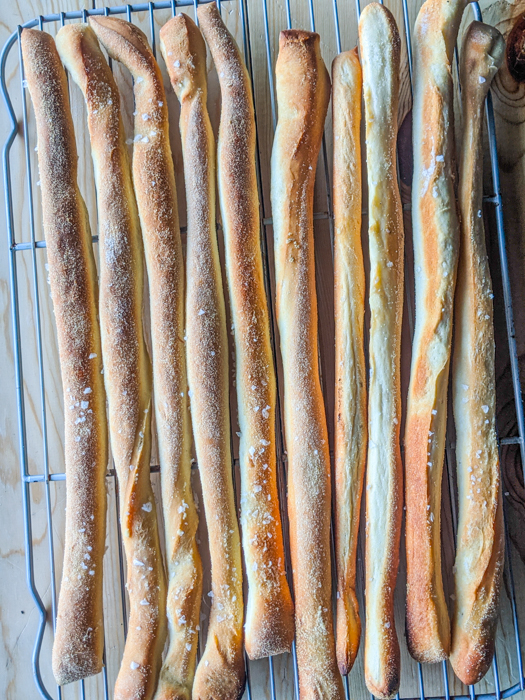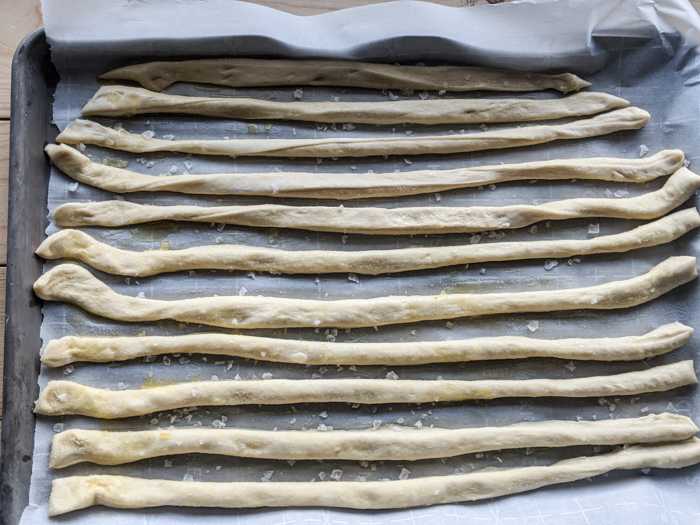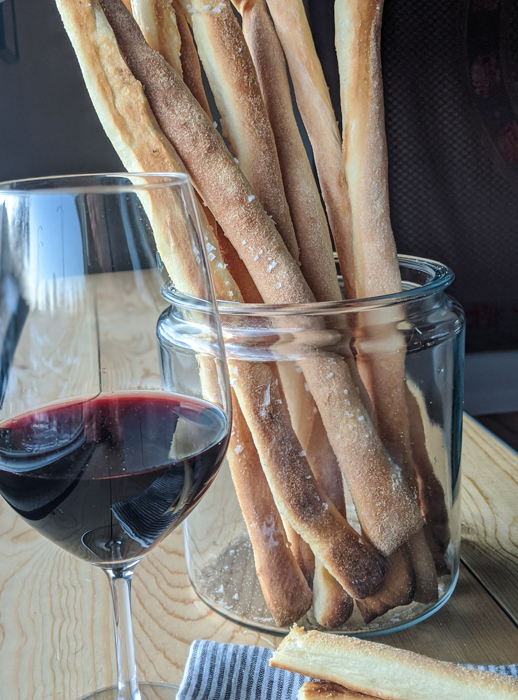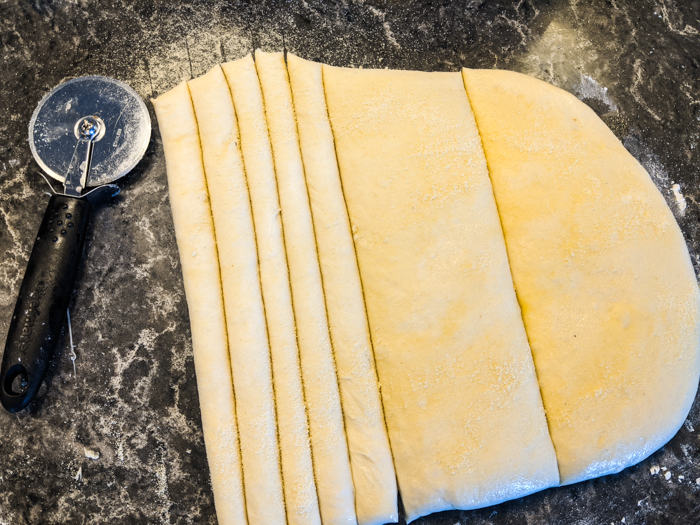
Bread sticks appear in almost every restaurant bread basket in Italy – wrapped in plastic, and enjoyable to munch on, but just ordinary. But on our visits to Piedmont on our Barolo Walk and Wine tours, fresh crisp bread sticks called grissini demonstrate how extraordinarily delicious such a simple food can be. Crunchy, crisp, flavored with fresh Ligurian olive oil and salt. I have to restrain myself to save room for the pasta course!

Grissini are seen all over Italy, but you are most likely to encounter them in their home region of Piedmont. The story of their origin dates them to the mid 17th century. Legend has it that Marie Jeanne, Duchess of Savoy, was concerned about the health of her son, Vittorio Amadeus II, and consulted with a doctor who then asked a baker in Turin to produce a bread that was more easily digestible than the standard white loaf, called ghersa. The baker used the same local ghersa recipe, taking pieces of dough and stretching them out to thin sticks about an arms length, then baking them to produce a crunchy cane that is all crust, which he called a grissino. They appear to have worked, as Vittorio Amadeus II lived to the age of 66, reigning as the Duke of Savoy as well as the King of Sardinia.

And he wasn’t the only royal fan – according to Carol Field, in her book The Italian Baker, when Napoleon discovered “les petits bâtons de Turin” he was so enthralled with them that he created a fast postal service to deliver his daily grissini fix to court each day. Once you experience the freshly baked version, you’ll understand. They are addictive.
The following recipe is adapted from Carol Field’s recipe in The Italian Baker. I seasoned mine with crunchy sea salt, but other variations include poppy seeds, sesame seeds, chopped fresh or dried rosemary, or grated cheese like Parmigiano-Reggiano. Use a good quality olive oil.

Enjoy with one of Piedmont’s amazing wines – a white Arneis from Roero or a red Barbera would wash these down beautifully.
Grissini Torinesi – Italian Breadsticks
Ingredients – Makes 20 grissini
1 3/4 teaspoons active dry yeast
1 tablespoon honey
1 1/4 cups warm water (or 1/4 cup warm water plus 1 cup cold water if using a food processor)
2 tablespoons extra-virgin olive oil, plus more for brushing
3 3/4 cups unbleached all-purpose flour, plus more for the work surface
1 1/2 teaspoons salt
1/2 cup cornmeal or coarse semolina flour, plus more for dusting the baking stone (optional)
Make the dough by hand: Stir the yeast and honey into the warm water in a large mixing bowl; let stand until foamy, about 10 minutes. Stir in the oil. Add the all-purpose flour and salt and stir until the dough comes together. Knead on a lightly floured surface until smooth, soft, velvety, and elastic, 8 to 10 minutes.
Make the dough with a stand mixer: Stir the yeast and malt into the warm water in a mixer bowl; let stand until foamy, about 10 minutes. Mix in the oil with the paddle. Add the all-purpose flour and salt and mix until the dough comes together. Change to the dough hook and knead at low speed about 3 minutes. Finish kneading briefly by hand on a lightly floured surface.
Make the dough with a food processor: Stir the yeast and malt into the 1/4 cup warm water in a small bowl; let stand until foamy, about 10 minutes. Place the all-purpose flour and salt in a standard food processor fitted with the dough blade or a large (over 7-cup capacity) processor fitted with the steel blade and process with several pulses to sift. Mix the 1 cup cold water and the oil in a small bowl. With the machine running, pour the water mixed with oil and the dissolved yeast through the feed tube and process until the dough comes together. Process 45 seconds longer to knead. Finish kneading briefly by hand on a lightly floured surface.
Pat the dough with your hand into a 14-by-6-inch rectangle on a well-floured surface. Lightly brush the top with oil. Cover loosely with plastic wrap and let rise until doubled, about 1 hour. Preheat the oven to 450ºF. Line 2 baking sheets with parchment paper.

Sprinkle the dough with the cornmeal or semolina flour before cutting and stretching. The traditional method of shaping bread sticks is ingenious, simple, and quick, and doesn’t make you roll out individual grissini. Cut the dough crosswise into 4 equal sections and then cut each section crosswise again into 5 strips, each about the width of a fat finger. The dough is so elastic that you can simply pick up each piece, hold each end with your fingers, and pull and stretch to fit the length of a baking sheet. Place the bread sticks on the baking sheets so they do not touch each other. (We find it easier to use the backs of the baking sheets, unless you have rimless sheets). There is no need to let them rise.
Bake the bread sticks for 20 minutes. Rotate the sheet pans halfway through, and flip the grissini to ensure even browning. If you like crunchy bread sticks, transfer the bread sticks directly to the baking stone for the last 5 minutes of the baking time, but only after sprinkling the stone with cornmeal or coarse semolina. Let the bread sticks cool on racks.
My observations: This recipe makes 20 rather fat grissini, so they were not crunchy all the way through when well-browned on the outside. If you wish thinner bread sticks, set up 4 sheet pans rather than two, cut each of the twenty dough lengths in half, and pull each half to be the size you desire. You will likely have to bake in two batches, but you end up with lots of grissini!

Pingback: Grissini Torinesi – Italian Bread Sticks – Lajawab Recipes